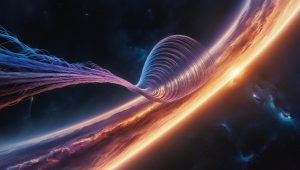
WORMHOLES:COSMIC SHORTCUTS
What if you could rocket from Earth, not to the Moon or Mars, but down a wormhole that loops all the way across the vast Milky Way, slashing travel time
Stars, the dazzling points of light that fill up the evening skies are the foundation of galaxies plus the cradles of life itself. From their birth in large clouds of gas as well as dirt to their ultimate death, stars undergo an intriguing and also intricate life cycle. Recognizing just how stars are birthed, live, together with pass away not just grows our understanding of deep space however likewise exposes crucial details concerning the beginnings of aspects that make up every little thing around us, consisting of life in the world.
Birth of a Star: Nebulae and also Protostars
stars are birthed from clouds of gas along with dirt referred to as nebulae. These clouds, usually made up largely of hydrogen can cover light-years throughout room. A star’s trip starts when areas within the nebula come to be unsteady because of disruptions such as shockwaves from neighboring supernovae or gravity communications. These disruptions create pockets of gas plus dirt to break down under their very own gravity.
As the cloud breaks down it separates right into smaller sized, denser clumps that warm up as they press. This home heating procedure is an outcome of gravitational power being transformed right into thermal power. As the core of among these clumps, referred to as a protostar warms up it starts to radiance. Though the protostar radiates it is not yet a full-fledged star due to the fact that nuclear blend– the procedure that powers stars– has actually not yet stired up.
Throughout this stage, the protostar remains to gather mass from its bordering gas plus dirt. The stress plus temperature level in its core continuously boost till they get to a crucial limit.
Keys Sequence: The Long Life of Stability
When the core temperature level of the protostar gets to about 10 million levels Celsius, nuclear combination stirs up. Hydrogen atoms start to blend right into helium launching large quantities of power through light and also warmth. This procedure notes the birth of a real star, as well as it gets in what is referred to as the major series stage of its life cycle.
Throughout the major series stage a star accomplishes a fragile equilibrium in between 2 opposing pressures: gravity drawing internal along with the stress from nuclear combination pressing exterior. This balance enables the star to preserve a secure dimension as well as radiate continuously for millions to billions of years depending upon its mass.
For stars like our Sun, the primary series stage can last around 10 billion years. Bigger, a lot more substantial stars shed their gas a lot quicker as well as have much shorter life expectancies while smaller sized, much less huge stars can stay in this stage for 10s of billions of years.
Red Giants as well as Supergiants: The Beginning of completions
When a star tires its supply of hydrogen in the core it encounters a brand-new difficulty. Without hydrogen entrusted to blend the core agreements under the pressure of gravity. This tightening creates the temperature level to increase once again as well as the star starts to blend helium right into larger aspects like carbon and also oxygen. At the same time the external layers of the star increase substantially together with the star comes to be a traffic signal titan or when it comes to even more huge stars a traffic signal supergiant.
For stars comparable in dimension to the Sun this traffic signal titan stage is a reasonably short-term however amazing duration. The external layers of the star inflatewards, cooling down as they increase plus the star tackles a reddish color. In this stage the star might lose its external layers developing a stunning covering of ionized gas called a worldly nebula. At the facility of this nebula continues to be the core of the star which will at some point come to be a white dwarf.
Enormous stars go through an extra significant change. After tiring helium these stars have the ability to blend considerably much heavier aspects in their cores– carbon, oxygen, neon, plus so on– up until they develop an iron core. Considering that iron blend does not launch power the core comes to be unpredictable resulting in a disastrous collapse.
Fatality of a Star: White Dwarfs, Neutron Stars, as well as Black Holes
The fate of a star after it leaves the major series depends greatly on its mass.
For stars with a mass comparable to or much less than the Sun after the traffic signal stage the core diminishes right into a thick, warm things called a white dwarf. White overshadows are incredibly tiny however have to do with the very same mass as the initial star. They no more undertake combination together with rather gradually cool down over billions of years up until they come to be chilly, dark items referred to as great voids– though this phase has actually not yet been observed as deep space is not old sufficient.
For even more large stars completion is much more eruptive. When the core of a large star breaks down it activates a supernova, among one of the most energised plus fierce occasions in deep space. The supernova surge surprise the external layers of the star spreading components like carbon, oxygen, plus iron right into space– components that will certainly eventually create brand-new stars, earths, together with also life.
The core that stays after a supernova can turn into one of 2 things, relying on the star’s preliminary mass. If the core is in between concerning 1.4 along with 3 times the mass of the Sun it comes to be a neutron star– an amazing thick things made up nearly totally of neutrons. Neutron stars are so thick that a solitary tsp of their product would certainly evaluate as long as a hill on Earth.
If the core is a lot more large, it breaks down right into a great void a region of room where gravity is so solid that not also light can get away. Great voids are amongst one of the most strange plus remarkable things in deep space coupled with they remain to intrigue stargazers as well as physicists alike.
The life cycle of stars is not simply a one-way trip from birth to fatality. When stars pass away they launch the aspects they developed throughout their life times back right into area expanding the bordering interstellar tool with larger aspects. These components, consisting of carbon, oxygen, along with nitrogen, are the foundation of earths, moons, together with life itself. New generations of stars will ultimately create from this product proceeding the planetary cycle.
In understanding the life cycle of stars, we also gain insight into the broader cyclees that shape the universe. From the birth of new stars in nebulae to the dramatic deaths of massive stars in supernovae, each phase of a star’s life is a crucial part of the ever-evolving story of the cosmos.

What if you could rocket from Earth, not to the Moon or Mars, but down a wormhole that loops all the way across the vast Milky Way, slashing travel time

If you go outdoors on a clear evening and also search for it, you might have the ability to see Jupiter beaming brilliantly amongst the celebrities. At the exact same

In the mission to recognize deep space mankind has actually developed progressively effective devices to observe deep space. Completion of this venture is the Extremely Large Telescope (ELT) which is

Space debris, also known as space junk, refers to the defunct artificial objects orbiting Earth. These objects include decommissioned satellites, spent rocket stages, and fragments from collisions and explosions.

The search for exoplanets– planets that orbit stars outside our planetary system– has actually quickly developed into one of the most interesting and dynamic fields of astronomy

Gravitational waves stand out as a remarkable finding in today’s universe explorations. Over a century ago Albert Einstein predicted that these waves exist in the fabric of space-time. By generating
Write to
Jasmine Gogoi at csr@scientifictemperament.com
Let’s develop our society with a scientific heart. Join us to build the scientifically nurtured future →